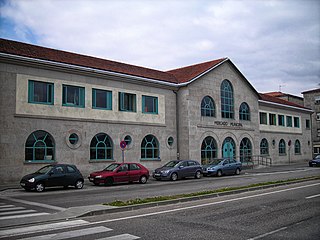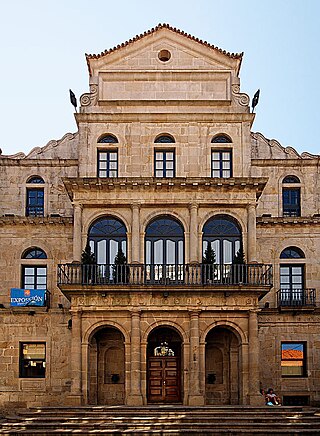
The church of the Pilgrim Virgin is a scallop-shaped Roman Catholic chapel located in the city of Pontevedra, in Spain, along the route of the Portuguese Way of St. James.

The Valle-Inclán High School is a large eclectic and Art Nouveau building located in the city centre of Pontevedra, Spain. It is named after the writer Valle-Inclán who studied and lived in Pontevedra. Today it is the seat of the Valle-Inclán Secondary School and was the first and the only secondary school in the province of Pontevedra from 1845 to 1927.

The Pontevedra City Hall in Pontevedra, Spain, is the seat of the city council of this Galician city. It is located at the eastern end of the Alameda de Pontevedra, on the edge of the old town. To the west it opens onto the pedestrian España Square.

The Plaza de Toros de Pontevedra (Spain) is the bullring of the Spanish city of Pontevedra and the only one in the autonomous community of Galicia. It has a capacity of 7,800 spectators and is classified as the second category of Spanish bullring. The current bullring replaced a wooden one dating from 1892, although the tradition of bullfighting in Pontevedra dates back to the 17th century.

The Principal Theatre of Pontevedra (Teatro Principal de Pontevedra) is a theatre in the old town of Pontevedra (Spain).

The former College of the Jesuits is an 18th-century baroque building located in Sarmiento Street in the heart of the old town of Pontevedra, Spain. A secondary educational institution founded by the Jesuits in 1695, the building is known today as the Sarmiento Building and is one of the seats of the Pontevedra Museum.

The Bank of Spain building is an eclectic early-20th-century building in the Spanish city of Pontevedra.

The Plaza de la Verdura is a square of medieval origin located in the heart of the historic centre of Pontevedra (Spain). It is one of the liveliest medieval squares in the city.

The Central Market of Pontevedra is a covered market located in Pontevedra, Spain. It is located at the north-eastern edge of the historic centre, close to the Burgo Bridge. It overlooks the banks of the Lérez river and was inaugurated in 1948.

The Plaza de Galicia is a 20th century square located in the city centre of Pontevedra (Spain), on the edge of the Campolongo neighbourhood.

The Liceo Casino is a neoclassical building from 1878 located in the historic centre of Pontevedra, which houses the oldest cultural and leisure society in Pontevedra, Spain.

Curros Enríquez Square is a square of medieval origin located in the heart of the historic centre of Pontevedra (Spain), on the Portuguese pilgrimage way.

The Marquis of Riestra's mansion is an eclectic building with art Nouveau elements from the late 19th century located at 30 Michelena Street in Pontevedra, Spain. It currently houses the main central administrative services of the City Council of Pontevedra.

St. Joseph's Square is a 19th century square located in the centre of the city of Pontevedra (Spain), in the first urban expansion area, near the Campolongo neighbourhood.

The Chapel of the Holy Souls in Purgatory is a small neo-Gothic Catholic religious building located in the old town of Pontevedra (Spain), in Ánimas Street, near Curros Enríquez Square.

The calle Benito Corbal is a street in Pontevedra (Spain) located in the first urban expansion area of the city. It is one of the main streets of Pontevedra, known as the "Golden Mile".

The Calle García Camba is a street in Pontevedra (Spain) located in the city centre, in the first urban expansion area. It is one of the main streets of Pontevedra.

The Calle de la Oliva is a street in Pontevedra (Spain) located in the city centre, on the edge of the old town. It is one of the main streets of Pontevedra and one of the most commercial.

The Calle Michelena is a street in Pontevedra (Spain) located in the city centre, on the edge of the old town. It is one of the main streets of Pontevedra and one of the most commercial streets of the city.

The Calle Daniel de la Sota is a central street in the Spanish city of Pontevedra, located in the city's first expansion area. It is one of the best-known streets in Pontevedra.






















